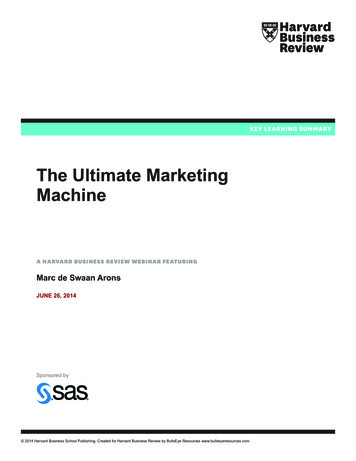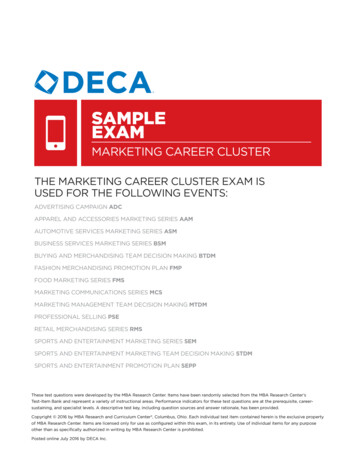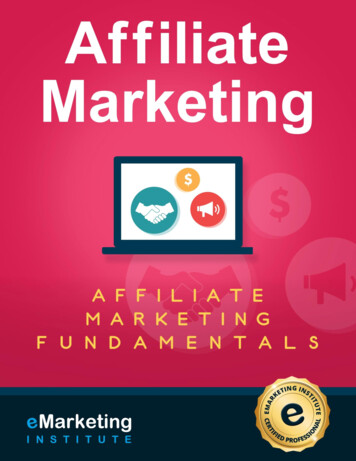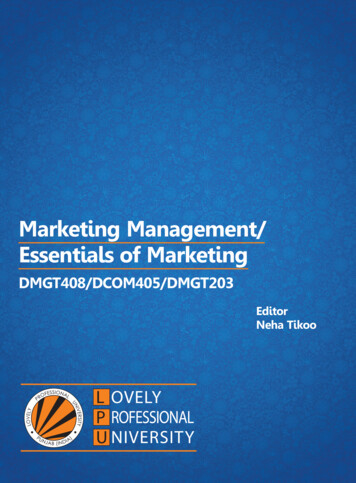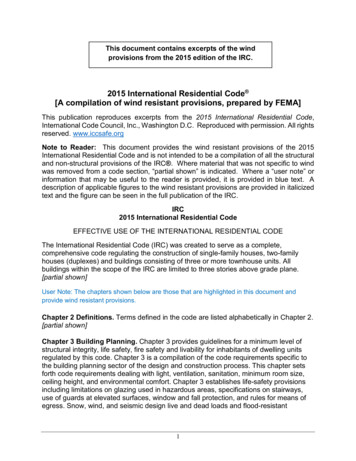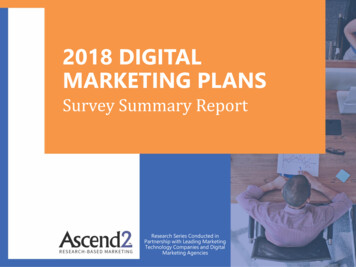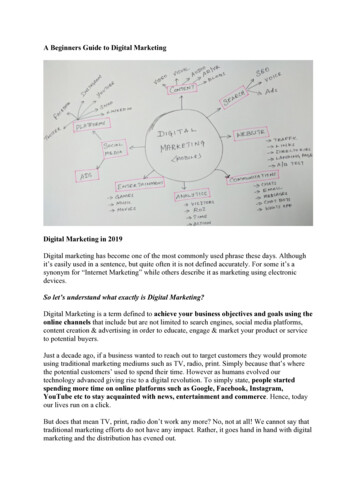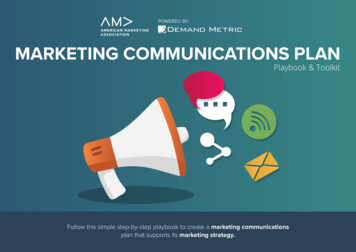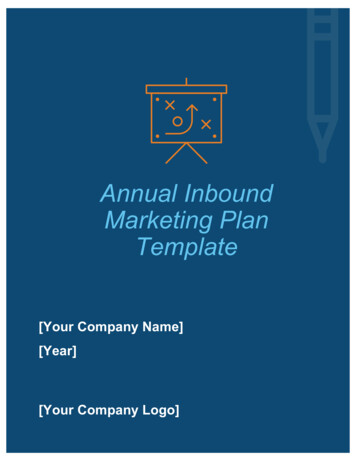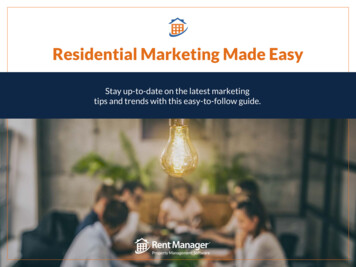
Transcription
Residential Marketing Made EasyStay up-to-date on the latest marketingtips and trends with this easy-to-follow guide.
Contents4 Tips For Creating aRebranding Plan2A Property Manager's Guideto Social Media4Tips and Tools for BetterReal Estate Photography7Building a Better Websitefor Your Property103 Tips for Writing CompellingProperty Listings12A Beginner's Guide toInternet Listing Services14Today, Marketing Matters More Than EverWith competitors a keystroke away, it's more important than ever to ensure you’reputting your best foot forward. We've compiled several of our blogs into this eBookto help your team create a positive first impression with prospects and tenants.For even more tips on how to make a marketing impact, follow our blog:RentManager.com/BlogFor more information on Rent Manager's comprehensive features,visit RentManager.com, or give us a call at 800-669-0871.
4 Tips For Creating a Rebranding PlanStrategic marketing and branding can make the difference between a thriving property and lasting vacancies. But like everything else,your brand needs a refresh every so often. While it requires some upfront cost and time, rebranding can ensure you’re attracting the rightprospects while laying the ground work for higher occupancy rates and increased tenant satisfaction and retention.We’ve compiled the tips on the next page to help you start your re-branding process.Page 2, 4 Tips For Creating a RebrandingPage 2, DesignPlan
Communicate with Current ResidentsPick the Right TimeSignificant changes, like upcoming capital improvements or purchasinga new property, present the perfect opportunity to update your brand.New features are a great selling point to catch the eye of a newresident! If you just purchased a new property, you will want to spendtime updating its branding to reflect its new ownership. This isespecially important in cases where the previous owners had a poorreputation. With reviews playing such an important factor in howpotential residents view your property, getting in front of a badreputation is critical. Rebranding is one way to assure current andfuture residents that “this isn’t who we are any more” and distanceyourself from old, unflattering reviews.While much of your rebranding process will focus on looking ahead,don’t forget about your current residents. Help existing renters feelincluded in your changes by sending out a survey to get feedback onwhich amenities and facets of your property are important to them. Usethis data to see what drew your tenants to your property in the firstplace, what is keeping them at your community, and which areas youmight want to focus on as you rebrand. When you settle on your newlook and feel, be sure to share the improved vision of your property withyour residents.Get SocialDepending on your budget, there are many tools available to get yournew message out to your target audience. Google Ad placement,geotargeting, and geofencing all help you reach groups in specific areasor businesses. These specific marketing placements can help you reach anew group of prospective renters that your old brand strategy leftbehind, or who may not have been open to your past marketing tactics.As your property grows and changes,Set GoalsCreate a list of goals for what you want to achieve with your newmarketing efforts and how you will measure your success. Take a good,hard look at where you are now, and where you need to be when itcomes to crucial metrics like occupancy and resident retention. Howcan your property reach a new audience of prospects? What strategiesand tools will you need to implement to make that happen? Goals canbe a road map to show where you are going, so take time to establishthem at the beginning of your rebranding process.so will your branding and marketinggoals. To compete in an ever-changingindustry, consider reevaluating yourbrand from time to time.Page 3, 4 Tips For Creating a Rebranding Plan
A Property Manager's Guide to Social MediaFrom marketing vacant units, to showcasing what life’s like in your community, to keeping your current residents updated; social mediais a great cost-efficient way for property managers to build a reputable online presence that’s reflective of their business.Nearly everyone is on social media in some capacity nowadays. The key is finding which platform best suits your business goals andprovides access to your target audience. Each social media platform offers different features and benefits. We will introduce the fourmajor social platforms—Facebook, LinkedIn, Instagram, and Twitter and review general tips that are applicable for all platforms so thatyou can better optimize your strategy.Page 4, A Property Manager’s Guide toPageSocial5, DesignMedia
FacebookWith the ability to reach more than two billion people, chat directly withfollowers, and share any type of media, Facebook is a must have forcompanies of all sizes. Facebook’s audience is broad, with a user agerange of 13–65 , though the most frequent users fall between the agesof 30–49.While still maintaining a professional demeanor, Facebook provides amore relaxed environment that is meant for videos, photos, gifs, andyes maybe even a cat video. Some great content suggestions includeinterior decorating tips, articles regarding local news, community eventinformation, and high-quality photos and videos of your units andproperty. Facebook also provides the ability to create groups that canserve as a more direct way to communicate information to yourresidents.Stay on targetAlthough there will be an overlap, each social media platform has itsown unique audience. Tailor and target your messaging for theaudience that’s consuming it. Finding the right voice is imperative tothe success of your efforts.Consistency is keyEach platform has its own algorithm and requirements; establishinga consistent schedule will be essential for your posting strategy.Finding what days and times your audience is most active on eachsocial channel and how often you need to post will help boostengagement and ensure your content is seen.Pay attention to trendsA hashtag trend or hot topic in the industry is a great way to joina larger conversation. Local and world news is also crucial to stayup-to-date on, as you will want to be considerate of your content.Visuals are vitalIt’s proven that including images and videos in your posts will drawmore engagement. When scrolling through their feed, a viewer is morelikely to stop and watch a visually appealing video or read a concisegraphic vs. plain-text posts.InstagramThe goal on Instagram is to provide a brand “experience” to followers inorder to tell a larger story through visual communication. Businesses thatintentionally develop and curate a brand style perform the best onInstagram. Using specific filters, colors, graphics, and hashtags can build astory and assist with brand recognition. Instagram stories highlightless-significant pieces of an overall brand story that may not require a fullpost. Stories are also a great way to engage with customers/followers andprovide an open line of communication through direct messaging.Hashtags are an important aspect of Instagram. By using the right hashtagsin posts, you can ensure that your content is seen by a like-minded audiencebeyond your followers. User demographics show this platform is morepopular with younger generations and only 35% of people 30–64 are usingit.Content suggestions for your Instagram audience include: Showcasing the lifestyle of your community through visuals Sharing employee spotlights so your tenants can get to know your staff Promoting engagement through weekly polls and questionsPage 5, A Property Manager’s Guide to Social Media
TwitterConsidered a miniature blogging platform, Twitter is all about keeping it short and sweet. The 250-character count keeps messages concise and direct.Focused on timely content, Twitter has become the place to get news with trending topics and hashtag conversations. It’s a great platform to keep yourcommunity updated with short posts, quick news, links to external sites, as well as delivering an additional customer service resource through DirectMessage. With that being said, the average life of a tweet is 24 minutes, therefore Twitter will require more frequent posting while still maintaining qualitycontent. Using one to three hashtags is the most effective way of getting your posts to a larger audience. Thirty-eight percent of Twitter users are betweenthe ages of 18–29 and more likely reside in an urban or suburban area.TikTok recently emerged and has been fully embraced by Gen Z—this video sharing social network was originally intended for talent videos related todancing and lip-syncing. These videos can be directly shared to other major platforms, the most popular being Twitter. TikTok could be a great way tocreatively share fun videos of your community and quick tours of units to your other platforms.LinkedInLinkedIn is the online equivalent of a professional networking event. Pages are extended resumes that generally include backgrounds, interests, education,and professional skills. As the most business-oriented platform, LinkedIn is great for building a brand, connecting with experts in a particular field, andgenerating new business leads. For property management specifically, you likely won’t be promoting your property to potential tenants, but ownerprospects may certainly be searching for details about your operation on this platform. LinkedIn is also a great resource for keeping tabs on industry trendsand to engage with like-minded property management professionals.User demographics for LinkedIn show the platform is most popular with people between the ages of 35–55. Generally, a more professional and direct toneis used when writing posts on LinkedIn. It can also be helpful to use from one to three hashtags in a post in order to engage in a larger professionalconversation.Social media is here to stay and will continue to be partof our everyday lives. Adopting the best platforms foryour business and embracing creative content will haveyour brand established online in no time.Page 6, A Property Manager’s Guide to Social Media
Tips and Tools for Better Real Estate PhotographyEye-catching photography is a must-have for property-management marketing and websites. Renters spend more than half of their onlinesearch looking at the images of potential homes, so it needs to be an area of focus for property managers.“I’m a property manager, not a photographer.” We hear you. That’s why we’re providing some essential tips and tools you can use to takebeautiful images of your property and make an excellent first impression.Page 7, Tips and Tools for Better Real Estate Photography
3 Key Aspects of Photography1. LightingThe key to a beautiful photo is lighting. Good lighting can make yourproperty feel fresh, new, and inviting. The easiest way to ruin a photois to shoot when it’s too dark, as it gives the space the appearance ofbeing smaller and dull. When taking photos of your property, be sureto utilize as much natural light as possible. Make sure blinds andcurtains are open to showcase the natural light. You also want to turnon any available interior lights to add brightness to the spaces.2. CompositionHere are some Do’s and Don’ts for editing your images:Good Brighten images Photoshop a blue sky if it’s a gloomy day Add watermarks to your photosNot Good Editing out permanent features of the building(satellite dishes, power lines, etc.) Editing out stains or damage to the unit Adding items that aren’t actually at the property–such asPhotoshopping grass and enhancing the landscaping.Composition is all about the layout and arrangement of the photo.A properly composed photograph captures key details and featuresof a room, and makes it appear more inviting. After all, the point ofphotographing your property is to appeal to your potential residentsand drive interest in your unit.TIP! For a better composition of a smaller space, stand in the doorwaywhen taking your photos. This will help you capture a more appealingangle and avoid making the area appear cramped.3. EditingOnce your images are taken and you’re back at the office, it's time tostart the editing process. This means making sure the brightness andexposure are balanced, but can also mean using tools like AdobePhotoshop to edit out unsightly elements. But this is an area where youneed to be careful, as there’s a fine line between enhancing andmisleading. It’s important that the images you capture and sharerepresent your property honestly and authentically.Page 8, Tips and Tools for Better Real Estate Photography
3 Key Pieces of EquipmentOther Things to Consider1. CameraAlways Plan AheadIf you’ve decided you want to handle your shoots in-house, you shouldconsider investing in a professional-quality DSLR camera that enablesyou to produce significantly higher-quality images than those yoursmartphone can provide.Before arriving for your photoshoot, plan a list of the shots you want tocapture and take multiple photos of each room from different angles.This helps things run more efficiently and eliminates the possibility offorgetting a critical shot. There are certain pictures you’ll always wantto get, regardless of the space.If purchasing a new camera isn’t an option right now, the easiestsolution is to use your smartphone. The cameras in today’s mobiledevices are more than capable of capturing great images when youfollow the key aspects discussed on the previous page.2. LensStaging vs. EmptyAre you going to furnish and stage the space, or leave it empty? Stagingthe unit can help viewers picture how their items would fit in the spaceand provides scale to the viewer. If you are going to stage the unit, keepit simple and furnish the space with neutral colors and minimalisticstyling to appeal to a wider audience. Avoid using personal photos oraggressive color schemes.A wide-angle lens comes in handy when photographing properties, as itallows you to capture the full scene. For interiors, this means you canfit more of your space in each image, helping your prospects get aclearer picture of the depth and layout of the unit. Composition is a keyaspect of photography, and a wide-angle lens helps solve the challengeof photographing a modest interior space. This isn’t just an accessoryfor those with a camera, either. If you’re planning to use yoursmartphone for your photography, look into the wide-angle lensoptions that are compatible with your device.Bonus Video3. TripodAerial/DronesThe last piece of equipment every property manager should considerwhen it comes to photography is a tripod. If you’re using a camera, atripod is a great tool to help ensure you snap high-quality pictures thatyou (and your audience) will love. When taking photos directly from ahandheld position, even the slightest shake or movement can causeyour beautiful photo to be ruined. Even the most basic tripod will helpstabilize the camera and remove the risk of images appearing blurry.A video walk-thru enables viewers to experience the entire layout ofthe space. The same key aspects and tools for photography remain truein the world of video.If your property is in a prime location or on a large plot of land, considerusing a remote-controlled drone to capture images and video from theair. Check with your local community for registered drone pilots whocan help you take your imagery to new heights.Page 9, Tips and Tools for Better Real Estate Photography
Building a Better Website for Your PropertyYour website is your digital front door. The content, design, and photos on your site create digital curb appeal for yourproperty. First impressions go a long way, and just like you would make sure the property and unit you were showingwas prepared to make a great impression, the same story goes for your website.Page 10, Building a Better Website forPageYour9,PropertyDesign
Where Do I Start?Start by researching your competition. What type of layout do theyuse? What is their messaging? What do their photos look like? Onceyou know what you’re up against, begin thinking about your targetaudience. Picture your ideal residents and use that insight to help craftthe appropriate messaging for your website.Communicating your property’s personalityAfter scoping out the competition it’s time to plan your website.Prospects value key information, like an engaging description of theneighborhood, and nearby attractions that make your communitystand out. Communicate the property’s value and positioning and alignyour content with the property’s brand to attract your ideal resident.A few key must-haves on your property’swebsite:#1. A picture is worth a thousand wordsHigh-quality photography helps tell the story of your property andgoes a long way in capturing the attention of your prospects. Ensurethe images you use represent your property honestly and authentically.#4. Closing the loopNow it’s time to close the loop with the call-to-action. Minimize theamount of time your units are vacant by clearly directing your prospectsto apply online or fill out a guest card. Easily accessible onlineapplications empower prospects to submit their information and makerenting more convenient for both the renter and your leasing team.Responsive design is a mustOnce you have identified a color palette that fits your brand and chosena user-friendly layout, it's time to ensure the site has a responsivedesign. A responsive website is a site that’s layout is optimizeddepending on the viewers screen size. So it doesn’t matter if a prospectis viewing from a computer, tablet, or their phone, they’ll be able tointeract easily with your website.Ready to enhance your first impression?Web appeal is the 21st Century’s curb appeal. The digital front door toany property management company is the key to making a good firstimpression in the eyes of a prospect. If you need help getting started orare looking for a website refresh, our talented team of web designerscan create a stunning, interactive website that fully integrates with RentManager.#2. Help viewers imagine the space as their ownHelp prospective tenants get a better feel for the space and invite themto imagine it as their own by including floor plans and dimensions inyour profile.#3. Now availableShow prospects the exact units available for rent. If you’re at 100%occupancy, include the dates the current leases are up. Market youravailable units the moment they’re ready by automatically linkingvacant, rent-ready spaces to your company’s site. When a unit’sinformation is updated in Rent Manager the change will automaticallyappear on your website, ensuring that you’re sharing the mostup-to-date details.Page 11, Building a Better Website for Your Property
3 Tips for Writing Compelling Property ListingsAccording to Microsoft, the average human attention span lasts eight seconds. That’s roughly the amount of time it takes topour a cup of coffee and add a dash of cream. As a property manager digitally marketing your vacancies, you have to make themost of your eight coffee-pouring seconds.We compiled the following tips to help you draft property overviews in a concise, compelling way that captures prospectivetenants’ attention in this era of perpetual scrolling.Page 14, 3 Tips for Writing Compelling Property Listings
Emphasize Renovations and AmenitiesIf you’ve recently made a physical and monetary investment inrefreshing your units, be sure to celebrate and emphasize thoseupgrades in your listings. Draw attention to those newly installedgranite countertops and stainless-steel appliances. Mention freshlyrenovated bathrooms, ample parking, as well as your property’scommunal spaces like gyms and pool areas. Now more than ever,renters are attracted to properties that offer amenities that enablethem to conduct fitness and social activities from the comfort of theirhome.Rather than a generic-sounding headline like, “Cozy 2 Bedroom Homeon a Quiet Street,” try, “Charming 2 Bedroom Home Nestled in theHeart of Charleston’s Historic District”.If you’re experiencing writers block and struggling with your wordchoice, take advantage of powerthesaurus.org or thesaurus.com tohelp liven up your lexicon.For apartments and single-family homes, Millennial and Generation Zrenters are looking for terms like “spacious”, “open concept”, and“balcony access”. If your properties are located in downtown,metropolatan areas, call out your community’s walkability to bars andrestaurants. On sites like Zillow, HotPads, and Trulia, you’re givenaround 250 words for your listing. Make them count.Avoid Words that Spark Negative Visualsor ConnotationsToday’s renters can read between the lines. In a study conducted byZillow, they found that words like "potential," "TLC," "cosmetic," and"opportunity" often signal that major fixes still need to be made, whileterms like “nice” are far too broad and ambiguous. Rather thanblanketing a listing as nice, describe what is NICE about it.Craft an Enticing HeadlineSince you only have about 250 to words to work with in a propertylisting description, it’s important to draw in your online audience with acaptivating headline. Your headline is your first impression and it helpsthe prospect create a visual of their life while living in your property.For example, if you’re advertising a home for rent near Charleston, SouthCarolina’s historic district, emphasize that prime location.Words most certainly have the power toinfluence—choose them thoughtfully. Conciselyand accurately describe your properties in a waythat makes them stand out, even during thoseeight, fleeting, coffee-pouring seconds.Page 15, 3 Tips for Writing Compelling Property Listings
A Beginner's Guide to Internet Listing ServicesIn any industry, it’s important to “be where your customers are”—and when it comes to leasing units at a rental property, thismeans being on an Internet Listing Service (ILS).Deciding which site(s) you want to advertise on depends on your industry, market, and property size. By combining your ILSpresence with a well-designed, user-friendly website, you’ll be on your way to finding your next tenants!Page 12, A Beginner’s Guide to Internet Listing Services
Strong VisualsHigh-quality photos and videos are a must for capturing the attention ofpotential renters. Place particular emphasis on the hero image (the firstphoto) viewers see when they visit your listing. Your lead photo shouldcapture visitors’ attention and pull them in for more information. Oncethe perfect shots are captured, you/your staff can upload the files directlyto Rent Manager from your smartphone via rmAppSuite Pro.*Property OverviewILS sites allow renters to filter their searches in a number of ways—fromspecific neighborhoods and price ranges to preferred property types andfeatures. To give your prospective residents the best idea of what life atyour property will look like, include diagrams, an overview of the area,amenities, and features lists in your property profile.Competitive PricingWhat is an ILS?An Internet Listing Service—an online real estate database—showsproperties and units that are available for rent or for sale. ILS sites area great way to get in front of potential residents in your area, as theyplay a key role in how potential renters research what’s available intheir desired market.Most ILS resources feature single-family homes, student housing, andmultifamily properties. There’s no shortage of ILS sites you can turn tofor attracting more leads. Rent Manager ILS Marketing integrates withseveral sites to market the available units/properties in your database.With varying advertising costs, ranging from pay-per-lead pricing ormonthly subscription packages, the increased visibility of your listingstypically outweighs the expense. Maximize the effectiveness of yourILS postings with the following tips.Prospects will be able to quickly compare your units with competition inyour area, so make sure your units are competitively priced. Utilizing RentManager’s ILS Marketing* capabilities, you can ensure your UnitMarketing* information—including your property’s address, photos, andpricing—is always current with real-time updates. Prospective renters willlikely use filter capabilities to select their preferred price range, so havingthe most up-to-date information included in your listings is key toattracting qualified prospects.Link To Your WebsiteOnce prospects find your property via their ILS searches, drive them toyour website or online application portal via an easy-to-find direct link toyour property’s site. Using ILS platforms to connect prospects with yourwebsite, you can tell your community’s whole story.Which site(s) you advertise on depends on your industry, market, andproperty size. By combining your ILS presence with a well-designed,user-friendly website, you’ll be on your way to finding your next residents!*To learn more about these Rent Manager features, press the F1 key in your Rent Managerdatabase to access the Help File.Page 13, A Beginner’s Guide to Internet Listing Services
Each social media platform offers different features and benefits. We will introduce the four major social platforms—Facebook, LinkedIn, Instagram, and Twitter and review general tips that are applicable for all platforms so that you can better optimize your strategy. Page 4, A


